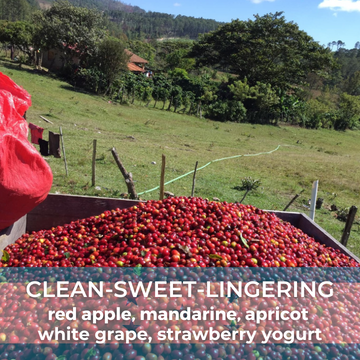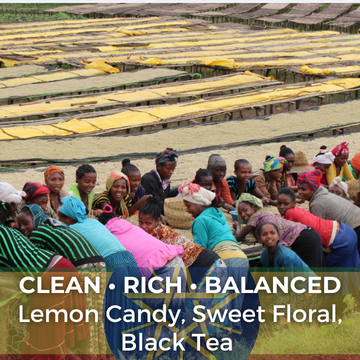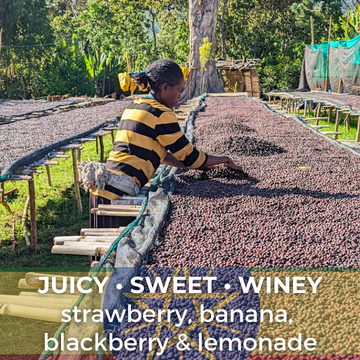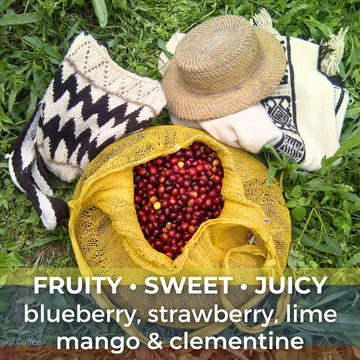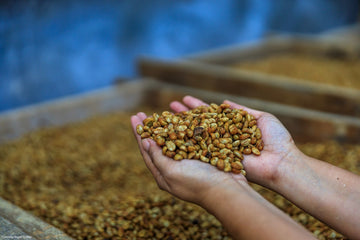Coffee Roasting Terminology
Coffee Home Roasting Terminology
Coffee Tasting Terms
The Coffee Definitions and Home Roasting Coffee Terms in this section are used in "scoring" our coffees during cupping—Cupping is what we coffee geeks call a coffee tasting. They are generally subjective, and should only be used as comparisons with other coffees.
Acidity Not the esophagus eroding stuff, but rather a pleasant tartness, snap, or twist akin to the snap of a fresh apple or a dry white wine. Generally found in coffees grown at higher elevations. A desirable trait. Other terms used to describe acidity are brightness, crispness, high notes, dry, and vibrant. Fully washed coffees tend to exhibit the most acidity, while natural processed coffees and especially wet-hulled coffees (i.e. Sumatra) have the least. Also commonly referred to as the "front end" of the coffee or the first taste sensation.
Aroma Basically the smell of brewed coffee in the cup. Different from fragrance which is the smell of freshly ground coffee that hasn't been brewed. The aroma often gives hints of what may be expected by the taste buds. It may smell rich (heavier in body), acidy, or there may be floral or fruit tones. Colombian coffee is often very aromatic. We score based on intensity and overall appeal.
Body The physical sense of coffee in the mouth. Heaviness, richness, and thickness or texture may be felt on the back of the tongue. Like red wines are heavier than white, some coffees have more body than others. Generally, coffees grown at lower altitudes tend to be a bit heavier in body than their higher grown counter parts which tend to be higher in acidity. Having said that, it is not a hard and fast rule, but just a guide.
Finish Just as aroma is the overture, finish is the finale. It describes the aftertaste that lingers after the coffee is swallowed. Heavier bodied coffees may have a longer finish. A good, fresh coffee should not have a bitter aftertaste. We score based on intensity, length, and lasting impression.
Fragrance While not a taste term, per se, fragrance is an essential part of the coffee, and as you may know, a lot of what you actually "taste" is done through smell. As explained above, fragrance is the smell of dry, freshly ground coffee before brewing. It offers another hint at what may be expected in the cup. Earthy, spicy, floral, smoky, deep, rich, and sharp are all terms used in describing fragrance. Colombian and Ethiopian coffees excel in this category. Here we score based on intensity and how much that fragrance makes us want a cup!
Taste Flavor. Obviously a coffee taste, but perhaps hints of fruit, flowers, chocolate and smoke may also be present. Taste tends to change as coffee cools in the cup. Very dependent on the roast profile. We score by intensity and depth.
Other coffee taste terms
Clean Without off-flavor or obscured taste. Generally a desirable trait, but some of the more exotic coffees may often not be described as "clean". Monsooned Malabar, for instance, is not a "clean" coffee, but yet has a great (albeit somewhat different) flavor, especially when used as a blender with other coffees.
Complexity A shifting of flavors and sensations in the cup. As a complex coffee cools, the flavor and some times the mouth-feel of the coffee change. Very much influenced by the roast profile you choose.
Twisty Sometimes a negative term, meaning a coffee that shows different characteristics in a single cup or from cup to cup. On the other hand, consider Ethiopian Harrar--a coffee that could be called "twisty", but in a good sense in that it's dry processing produces a sort of "wild" flavor that makes it very intriguing and interesting to both the nose and the palate.
Varietal / Variety Also known as "cultivar". There are many, many varietals or cultivars of Arabica and Robusta coffee. Much like with wine (say a Riesling vs a Cabernet Sauvignon), these varietals all have different flavor and cup attributes and offerings can be single varietal offerings, like a Bourbon only lot or in blends of complimentary cultivars. Other common varieties include Typica, Caturra and Gesha just to name a few.
Terms Used in green Coffee bean Roasting
Pre-heat For many home roasters, this is a critical stage. It's running the roaster on a high temperature for a long enough period of time to get the materials in the roaster (metal, glass, etc) up to high temperatures. This allows the roaster's energy to be focused on the beans once their loaded or charged. Just like you pre-heat your oven before putting in your frozen pizza.
Charge To load the beans into the roaster and begin the roasting process. Charge weight is the amount of beans loaded (usually in grams, ounces, kilos or pounds).
Drying Stage The first stage in the roasting process. Usually marked by a large injection of heat into the beans called "ramping" in order to gain thermal momentum for the remainder of the roast.
Yellow Point / Dry End When the beans reach the end of the drying stage, they will turn a relatively uniform pale yellow color. Usually occurs when the internal bean temperature reaches ~300 - 320 degrees Fahrenheit.
Maillard / Caramelization / Browning Stage The middle phase of the roasting process. During this stage, the rate of bean temperature increase (also called Delta BT or Rate of Rise-RoR) should begin to level off or decrease. Also, this is when the Maillard Reaction, commonly called caramelization occurs. VERY simply put, that means the compounds inside the bean such as amino acids and sugars are breaking down and reforming into other compounds which give coffee the flavor and body we love.
First Crack This is a distinctly audible "popping" or cracking sound the beans make during the roasting process. It is generally accepted as the point where pyrolysis begins (around 485 degrees internal bean temperature) and due to chemical changes inside the coffee bean, they begin to emit their own heat, thus raising the temperature inside the roasting chamber. This is the first point where your coffee is "coffee"—the very lightest roast profile—though it's probably not very good at this point. The first crack denotes the beginning of the final stage in the roasting process, known as the development stage.
Second Crack This is the point during the roasting process where your coffee enters the "dark roasted" realm. After the First Crack noise subsides, a few moments pass. How long depends on your roaster, how big your roast batch is, the type of bean, and a lot of other things and then the Second Crack begins. At this point the woody matter in the bean begins to change. The Second Crack is more rapid, (kind of like Rice Crispies). The Second Crack is a major reference point for roasters. They often speak of roasting "just short of the second crack; just into the second crack, well into the second crack, etc.
Drop To end the roast by removing the beans from the heat source. Whether you drop your beans into a cooler separate from your roaster or use your roaster's cooling cycle, it's important to cool your beans as quickly as possible to halt the development and roasting process exactly where you want to.
Chaff The papery stuff that comes off the coffee during roasting. It is actually the innermost skin, or silverskin, of the coffee bean that remains attached to the bean after processing. What ever your roasting method, chaff must be dealt with in order to avoid a mess, or in extreme situations, a fire. Popcorn popper roasters, just catch it in a bowl under the chute. Dedicated home coffee roasters come with efficient chaff collectors. Just empty it between roastings.
Coffee Defects
Underdeveloped Coffee that has been roasted too quickly. If you cut open the bean, the interior will be lighter than the exterior. The cup tastes grassy or sometimes even sour and acrid.
Baked Underdeveloped coffee that is browned but tastes flat and empty. Usually caused by the coffee being roasted at too low a temperature for too long a time.
Quakers Also known as "floaters". These under ripe beans are usually culled during processing by soaking the fresh picked beans in a large container of water. The under ripe beans float to the top and are removed. Some make it through processing, though, and can be noted in roasted batches by their significantly lighter roast appearance than the rest of the batch. Feel free to remove them.
Coffee Bean Grades, Types of Green Coffee Beans and Other Terms
The coffee itself has certain terms and abbreviations associated with it that are primarily used by people within the industry to describe the coffee. In this section I'll try to explain those we use here at The Captain's Coffee. Hope it helps you understand the coffee a bit more.
Certified Organic Coffee Coffee that carries the "organic" label has been tested and certified to have been grown, processed, shipped and packaged without exposure to agricultural chemicals or other chemicals. It is as "natural" as it can be. The certification process is lengthy and expensive. Because of the time and expense, many farmers can't afford to have their coffee certified. In fact, most coffee is grown with little or no chemicals if for no other reason than that the farmer can't afford them. This is particularly true in the Ethiopian and Sumatran/Sulawesi coffees we carry. We sometimes debate about only offering organic coffee, because being organic does not necessarily mean better coffee. On the other hand, if the farmer has gone to the time and trouble to have his coffee officially certified, they generally take other measures to insure quality. All of which means a more expensive coffee. To add to this debate, there are many farmers who grow and process their coffee organically, but cannot afford the expensive certification process or have higher priorities for their profits, such as adequate housing for their workers or schools for their worker's children. We think it's important to support these farmers as well. When we carry these coffees, we go to lengths to note their adherence to organic farming practices in an effort to acknowledge their ongoing growth but more importantly, their dedication to their community first.
SHG and SHB Coffee Beans These abbreviations stand for "Strictly High Grown" and "Strictly Hard Bean" respectively. The terms are used primarily with Central and South American coffees to describe the growing conditions and quality of the bean. As you'd imagine, Strictly High Grown coffee is grown at higher altitudes, normally above 3,500 feet above sea level. Strictly Hard Bean is really only another descriptor for high grown coffee. Since the bean grows more slowly at higher altitudes, it tends to be denser, or harder. Slower growth allows more acidity to develop, and the flavors to be more intensified. High grown or hard bean coffee is generally thought of as higher quality. But not always. Consider lower grown Sumatra Mandheling.
Shade Grown and Bird Friendly These terms pretty well explain themselves, and are used not only to describe growing conditions, but to appeal to environmentally conscious consumers. Shade Grown coffee is grown in the shade (duh!) of taller trees, many of which are old growth. Certain coffees are certified by organizations such as the Rain Forrest Alliance to be grown in this manner, and they get the "Bird Friendly" stamp. Although many coffees are grown in the shade, the certification process is lengthy and expensive, so to date only a few farmers have been able to be officially certified as "Bird Friendly" growers. On some plantations, the old trees were all cleared, vast plantings of coffee occurred, and then taller growing trees were planted to shade the coffee plants. On some farms, the old trees were left and the coffee trees planted among them. Why? Yes, there is an environmental concern, but a major reason is that shade grown coffee matures more slowly, allowing acidity, flavor and body to develop more thoroughly than in the same coffee planted in full sun. A win-win arrangement. The birds and environment get a break, and we get better coffee. But there is a down side for the farmer, too. Shade grown coffee plants produce less coffee per plant and per season than coffee planted in full sun. That's one reason that Shade Grown and Bird Friendly coffees are more expensive.
OK, I'm off to roast some coffee. More later...
